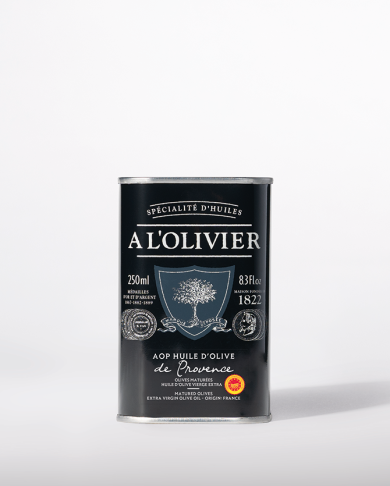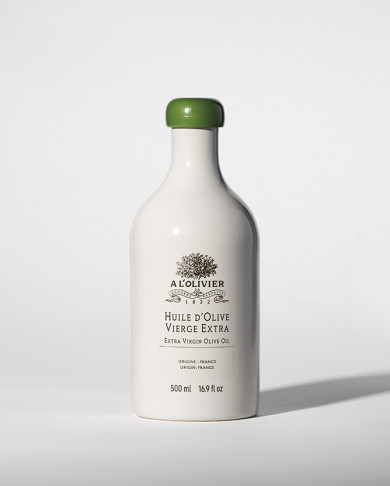INSPIRATIONS


Terroir and expertise
| 23.10.2021
EXTRA VIRGIN, PDO: CHOOSING THE RIGHT OLIVE OIL

When it comes to choosing the right olive oil for you, it can be difficult to navigate through all the marketing and beautiful bottles! Here are our top tips for selecting the best oils.
Olive oil: an overview
Olive oil is a delicious staple within the well-known Mediterranean diet and enjoys a great gastronomic reputation. It’s one of the favourite vegetable oils among food lovers and those invested in their health. This oil is obtained by exclusively mechanical processes. To find the right oil for you, don’t rely on beautiful labels with Provençal colour palettes: it’s always best to read the labels! This is a product that complies with the strict regulations set by the European Union.
Selecting a quality olive oil
There are several factors that indicate the quality of an olive oil, determined by both chemical and organoleptic criteria.
Extra virgin oils and virgin oils
Extra virgin olive oils are considered to be the best olive oils, and they must be free of any organoleptic defects. Their oleic acid level is less than 0.8%, while this can be up to 2% in virgin olive oils. The latter may have very slight taste defects depending on the regulations. In any case, cold pressing is intrinsic to the manufacture of olive oil in modern mills that use continuous and centrifugal processes. The term “first cold pressed” refers to a bygone era when olive press mills, which had equipment less powerful than today’s, carried out a second pressing with hot water.
Designations (PDO, AOC)
PDO (Protected Designation of Origin) and AOC (Appellation d’Origine Contrôlée) are equivalent designations. The first is a set of standards relevant to European territory while the second is specific to France. Both attest to a strong link with the territory of cultivation and production, itself strictly delimited. France therefore has eight PDOs: Nyons, Baux-de-Provence valley, Haute Provence, Provence, Aix-en-Provence, Nimes, Nice and Corsica. The designation of origin is always clearly marked on labels, and it’s a guarantee of quality that ensures a flavoursome olive oil manufactured according to traditional processes.
Indication of origin
Aside from the designation, the indication of origin must be clearly stated on the packaging of any extra virgin olive oil sold in the European Union.
Fruitiness (black, green, mature)
The fruitiness indicates the olfactory and gustatory characteristics that depend on the ripeness and processing of the olives:
- Fruity green refers to olives harvested at the beginning of the season, before maturity. This gives these extra virgin olive oils a fresh, ardent and slightly bitter taste.
- Ripe Fruity refers to olives harvested at maturity. These olive oils are sweeter with a round flavour.
- Fruity black, characteristic of Provence, is made from olives that have undergone controlled fermentation. These olive oils reproduce the flavours of yesteryear, with aromas of black olive tapenade and earthy notes. They’re identified with the words “matured olives” or “old-fashioned taste".
The container
The best olive oils are generally packaged in metal tins and opaque or dark glass bottles. These materials protect them from light, as do stoneware bottles in which olive oil was historically sold. Plastic bottles are for lower quality oils, which can be used for cooking.
Olive oil filtration
Olive oil filtration (or filtering) removes residues from the liquid prior to bottling, ensuring better shelf life. However, some olive oil lovers find unfiltered oil more tasty... If you’re one of them, it’s best to choose oils made from recently harvested oils and consume them quickly; over the months, taste defects associated with unfiltered olive oils develop.
Storing olive oil
At home, olive oil should be stored in a cool, dark place.
Our selection of olive oils
For cooking, a good everyday olive oil is what you need. For example, our vintage olive oil from Spain. For a delicious garnish or dip, an olive oil with a designation is the way to go, for example, a French designation: PDO Baux-de-Provence valley on a crispy vegetable tartare; PDO Provence “mature” olive oil on mashed potato; PDO Haute-Provence drizzled over goat’s cheese or a vegetable tian, and DPO Nyons on fresh pasta or a fresh fruit salad with basil.
Our delicious fruity green extra virgin olive oil produced in the Grasse mill tastes great drizzles over a ceviche, and our fruity black olive oil from centuries-old olive trees is delicious with pan-fried vegetables or scallops. Real luxury olive oils!

 Menu
Menu
 Mon compte
Mon compte  Wishlist
Wishlist  Panier
Panier 


